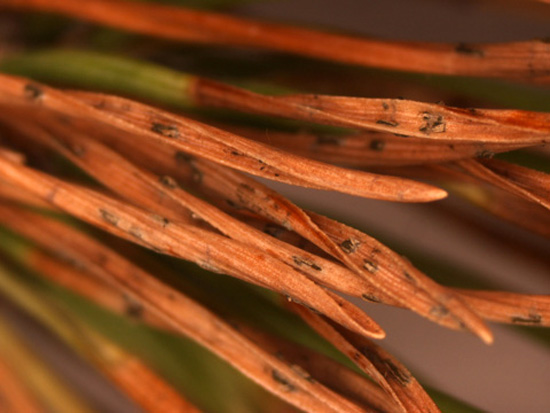Issue 16, September 14, 2009
Brown Spot Needle Blight on Scotch Pine
The Plant Clinic at the University of Illinois has received several samples of Scotch pines infected with brown spot in recent weeks. The disease is caused by a fungus called Scirrhia acicola; imperfect stage is Mycosphaerella dearnessii. Pine hosts include Scotch, Ponderosa, Austrian, and Eastern white pines, but Scotch is the most commonly infected pine in Illinois.
Symptoms first appear as brown spots on the needles, sometime with yellow bands. Eventually the needles turn brown from the tip back. Often they are covered with gummy pitch. By October and November, entire needles turn brown. Fruiting bodies form in the dead portions of the needles, as shown in the image (courtesy Travis Cleveland, Plant Clinic). Infection is often concentrated on the lower branches. The spores of this fungus help to confirm and distinguish this needle blight from Dothistroma or Lophodermium needle blights.

The brown spot fungus overwinters as fruiting bodies (ascocarps and pycnidia) in dead needles, or as fungal mycelium in infected needles. In the spring, spores are released during wet weather, and spore production increases until late summer. Spores are vectored by rain, animals, and pruning activity.
Once this disease is identified on your pines, follow cultural practices outlined in report on plant disease no. 624, Needle Blights and Needle Casts of Pines. Fungicides may be used to help prevent infection. Sprays are made when needles are half-grown and again 30 days later. In rainy conditions the spray interval may need to be shortened. Home growers can use chlorothalonil, copper, copper sulfate, and mancozeb products. A few more products are available for commercial applicators. Refer to the Illinois Commercial Landscape and Turfgrass Pest Management Handbook for a complete list of registered products.--Nancy Pataky
Author:
Nancy Pataky